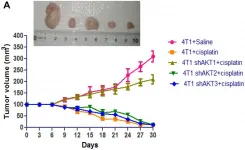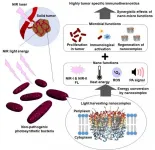(Press-News.org) Oncotarget recently published "AKT isoforms have discrete expression in triple negative breast cancers and roles in cisplatin sensitivity" which reported that the authors investigated the expression and net effect of the individual isoforms in triple negative breast cancers and response to cisplatin treatment using cellular, mice models and clinical samples.
Interestingly, analysis of the expressions of AKT isoforms in clinical samples showed relatively higher expression of AKT1 in primary tissues; whereas lung and liver metastatic samples showed elevated expression of AKT2.
Similarly, triple-negative breast cancer cell lines, BT-549 and MDA-MB-231, with high proliferative and invasive properties, displayed higher expression levels of AKT1/2. By modulating AKT isoform expression in MCF-10A and BT-549 cell lines, the Oncotarget authors found that the presence of AKT2 was associated with invasiveness, stemness and sensitivity to drug treatment.
It was further demonstrated that loss of function of AKT1 isoform is associated with reduced sensitivity towards cisplatin treatment in triple-negative breast cancers cellular and syngeneic mice models.
The decrease in cisplatin treatment response in shAKT1 cells was allied with the upregulation in the expression of transporter protein ABCG2, whereas silencing of ABCG2 restored cisplatin sensitivity in these cells through AKT/SNAIL/ABCG2 axis.
In conclusion, the Oncotarget study demonstrated the varied expression of AKT isoforms in triple-negative breast cancers and also confirmed the differential role of isoforms in stemness, invasiveness and response towards the cisplatin treatment.
"The Oncotarget study demonstrated the varied expression of AKT isoforms in triple-negative breast cancers."
Dr. Fayaz Malik from The Academy of Scientific and Innovative Research as well as The CSIR-Indian Institute of Integrative Medicine said, "Breast cancer is the second-most lethal cancer in women around the world."
Their team explored cisplatin resistance via AKT2 and AKT3 isoforms that lead to malignant human uterine cancer cells.
Nevertheless, to understand the significance of the outcomes driven by the AKT isoforms, in respect to normal versus malignant breast cancer it is important to characterize which AKT isoform leads to oncogenesis, or exerts self-contradictory effects, both promoting and impeding neoplastic phenotypes.
Therefore, the authors sought to determine the isoform-specific functions of AKT in triple-negative breast cancers.
To this end, they modulated AKT isoform expression in human mammary nonmalignant immortalized cell line, MCF-10A and malignant breast cancer cell line, BT-549 by knocking down endogeneous AKT isoforms using short hairpin RNA.
Interestingly, analysis of triple-negative breast clinical samples from primary and metastatic sites have shown differential expression of AKT isoforms. These studies, highlight the role of specific AKT isoforms in invasiveness and poor response to cisplatin treatment in Triple-negative breast cancers that needs to be evaluated further for the development of isoform specific inhibitors for better clinical outcome.
The Malik Research Team concluded in their Oncotarget Research Paper that the present work elucidated expressions of AKT isoforms varies in primary and secondary sites of TNBCs, which needs to be further validated by taking large sample sizes.
These studies unraveled the specific roles of AKT isoforms in stemness, invasion and therapeutic response of cisplatin in TNBCs, therefore suggesting that it is imperative to precisely design isoform specific inhibitors in the treatment of aggressive triple-negative breast cancers.
Sign up for free Altmetric alerts about this article
DOI - https://doi.org/10.18632/oncotarget.27746
Full text - https://www.oncotarget.com/article/27746/text/
Correspondence to - Fayaz Malik - fmalik@iiim.ac.in
Keywords -
AKT isoform,
CSCs,
ABCG2,
drug resistance,
TNBCs
About Oncotarget
Oncotarget is a biweekly, peer-reviewed, open access biomedical journal covering research on all aspects of oncology.
To learn more about Oncotarget, please visit https://www.oncotarget.com or connect with:
SoundCloud - https://soundcloud.com/oncotarget
Facebook - https://www.facebook.com/Oncotarget/
Twitter - https://twitter.com/oncotarget
LinkedIn - https://www.linkedin.com/company/oncotarget
Pinterest - https://www.pinterest.com/oncotarget/
Reddit - https://www.reddit.com/user/Oncotarget/
Oncotarget is published by Impact Journals, LLC please visit http://www.ImpactJournals.com or connect with @ImpactJrnls
Coffee, cola or an energy drink: caffeine is the world's most widely consumed psychoactive substance. Researchers from the University of Basel have now shown in a study that regular caffeine intake can change the gray matter of the brain. However, the effect appears to be temporary.
No question - caffeine helps most of us to feel more alert. However, it can disrupt our sleep if consumed in the evening. Sleep deprivation can in turn affect the gray matter of the brain, as previous studies have shown. So can regular caffeine consumption affect brain structure due to poor sleep? A research team led by Dr. Carolin Reichert and Professor Christian Cajochen of the University of Basel ...
Here is a link to watch a video interview with Dr. Beatrice Aramini about this topic on the Oncotarget YouTube Channel
Oncotarget published "Cancer stem cells and macrophages: molecular connections and future perspectives against cancer" which reported that Cancer stem cells have been considered the key drivers of cancer initiation and progression due to their unlimited self-renewal capacity and their ability to induce tumor formation.
Macrophages, particularly tumor-associated macrophages, establish a tumor microenvironment to protect and induce CSCs development and dissemination.
Many studies in the past decade have been performed to understand the molecular ...
For the first time, physicists from the University of Basel have produced a graphene compound consisting of carbon atoms and a small number of nitrogen atoms in a regular grid of hexagons and triangles. This honeycomb-structured "kagome lattice" behaves as a semiconductor and may also have unusual electrical properties. In the future, it could potentially be used in electronic sensors or quantum computers.
Researchers around the world are searching for new synthetic materials with special properties such as superconductivity -- that is, the conduction of electric current without resistance. These new substances are an important step in the development ...
Climate change is rapid in the Arctic. As the climate warms, shrubs expand towards higher latitudes and altitudes. Researcher Julia Kemppinen together with her colleagues investigated the impacts of dwarf shrubs on tundra soils in the sub-Arctic Fennoscandia.
The study revealed that the dominance of dwarf shrubs impacts soil microclimate and carbon stocks. Microclimate describes the moisture and temperature conditions close to ground surface. Shrubs are the largest plant life form in the Arctic, and in comparison, to other arctic plants, shrubs use more water and cast more shade.
"The results indicate ...
WASHINGTON -- When people pause before replying to a question, even for just a few seconds, their answers are perceived to be less sincere and credible than if they had replied immediately, according to research published by the American Psychological Association.
And the longer the hesitation, the less sincere the response appears.
"Evaluating other people's sincerity is a ubiquitous and important part of social interactions," said lead author Ignazio Ziano, PhD, of Grenoble Ecole de Management. "Our research shows that response speed is an important cue on which people base their sincerity inferences."
The research was published in the Journal of Personality and Social Psychology.
Researchers ...
Cancer is one of the most thought-provoking healthcare problems throughout the world. The development of therapeutic agents with highly selective anti-cancer activities is increasingly attractive due to the lack of tumor selectivity of conventional treatments.
Scientists at Japan Advanced Institute of Science and Technology (JAIST) have created a photosynthetic bacteria-based cancer optotheranostics (Figure 1).
Discovered by Associate Professor Eijiro Miyako and his team from JAIST, natural purple photosynthetic bacteria (PPSB) can play a key role as a highly active cancer immunotheranostics agent that uses the bio-optical-window I and II near-infrared (NIR) light thanks to the light harvesting nanocomplexes in microbial ...
There is no coat colour that distinguishes dingoes from dingo-dog hybrids, a study involving UNSW Sydney has found.
The Centre for Ecosystem Science research suggests that animals assumed to be dingo-dog hybrids based on their coat colour and culled may have been pure dingoes.
"We actually found pure dingoes that had a brindle, black and tan, patchy or sable coat colour," Dr Kylie Cairns, a conservation biologist from UNSW Sydney and co-author of the study said.
"So that's showing that really dingoes are much more variable than we think and seeing an animal with an odd coat colour doesn't immediately mean that it's a hybrid.
"Using coat colour to decide what animals should be culled is not a very good idea."
The study follows 2019 research by UNSW and collaborators which found ...
San Antonio, Texas (February 15, 2020) - Researchers at the Southwest National Primate Research Center (SNPRC) at Texas Biomedical Research Institute (Texas Biomed) may have found a new pathway to treat and control tuberculosis (TB), the disease caused by Mycobacterium tuberculosis (Mtb). Using single-cell RNA sequencing (scRNAseq), a next-generation sequencing technology, scientists were able to further define the mechanisms that lead to TB infection and latency. Co-led by Deepak Kaushal, Ph.D., Director of the SNPRC, this is the first study that used scRNAseq to study TB in macaques in depth. Results from the study were published ...
Scientists of Kemerovo State University, within the framework of the Russian Scientific Foundation grant "Cultivation of isolated cells and organs of rare and endemic medicinal plants of Siberia and the Far East in vitro as a biotechnological method for obtaining biologically active substances", are investigating the fundamental principles of in vitro cultivation of isolated cells and organs of rare medicinal plants - producers of biologically active substances with cytotoxic, antioxidant and antimicrobial properties. One of the urgent problems of medicine and biology is the search and use of plant objects as medicines. The unfavorable environmental situation and the increasing need for medicinal raw materials create its shortage. A new solution ...
In our ongoing struggle to reduce the usage of fossil fuel, technology to directly convert the world's waste heat into electricity stands out as very promising. Thermoelectric materials, which carry out this energy conversion process, have, thus, recently become the focus of intense research worldwide. Of the various potential candidates applicable at a broad range of temperatures, between 30 and 630 °C, lead telluride (PbTe) offers the best thermoelectric performance. Unfortunately, the outstanding qualities of PbTe are eclipsed by the toxic nature of lead, driving researchers to look into safer thermoelectric semiconductors.
Tin telluride (SnTe) could be an ...



